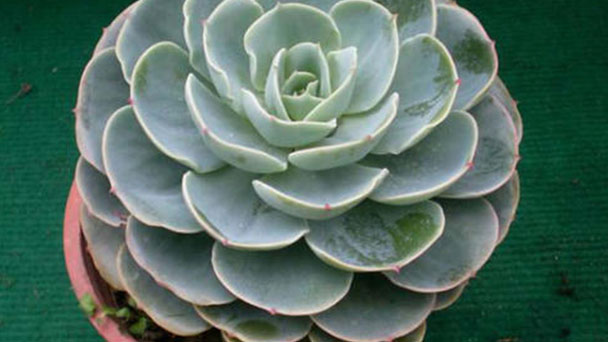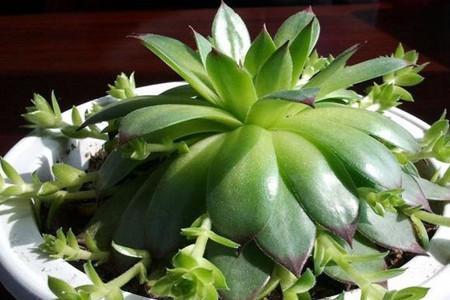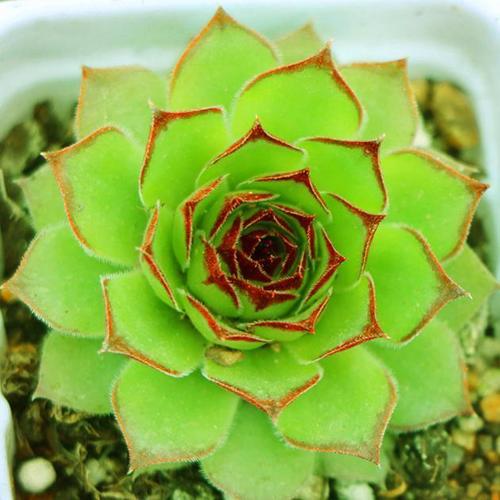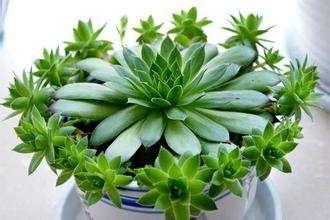Houseleek profile
Written by Maggie
Feb 09 2021

Houseleek, scientific name Sempervivum tectorum, a small succulent foliage plant, is dignified in shape, like a blooming lotus, with variegated leaves and a distinctive purple tip.
Houseleek picture

Houseleek distribution range
Houseleek (Sempervivum tectorum) originated in the mountains of southern Europe, and all over the country are cultivated.
Houseleek habits
Houseleek (Sempervivum tectorum) is suitable for full sunshine and cool, dry environment, in addition to the summer high temperature to appropriate shade, avoid sun exposure, other seasons to fully see the light, although in the half shade can also grow normally, but for some leaf tip is not green varieties, the leaf tip color is easy to fade, affect the ornamental. Houseleek is cold resistant, winter water control, and can withstand the low temperature of 2℃. Spring and autumn season growth season to keep the soil moist, every 2~3 weeks to apply a ripe liquid fertilizer, fertilizer water should be light rather than thick, especially nitrogen fertilizer content can not be too much, otherwise it will cause the Houseleek to grow. During the high temperature period in summer, Houseleek (Sempervivum tectorum) has a long dormant period, so it is necessary to shade the soil, pay attention to ventilation and cooling, keep the basin soil moderately dry, and prevent the plant rot caused by sultry and humid conditions. Turn the basin every 1~2 years in the spring, the basin soil should be fertile, and have good drainage, air permeability. Commonly used leaf rot soil 2, coarse sand, vermiculite each 1 mix after use, and add a small amount of plant ash, bone meal as the base fertilizer.When turning over the pot, the roots should be sorted out to remove rotting or over-long roots. After a little drying for a day, plant them in a larger pot with new culture soil.
Houseleek characteristics
Houseleek (Sempervivum tectorum) is a small fleshy plant the plant dignified, like a blooming lotus flower, leaf color abound change, purple leaf very chic, suitable for small and medium-sized or combination of potted plants, with different formative flower pot plants. Houseleek ornamental effect also vary widely, with cartoon type flower pot planting, lively and lovely, popular children's welcome; With purple arenaceous basin or blue and white porcelain basin planting, dignified and generous, quite favored by the elderly; And planted in wooden floret basin, fashion and nature, very popular with young people.
Houseleek (Sempervivum tectorum) for crassulaceae Houseleek is a perennial succulent, plants with rosette semal, many varieties, semal from 3 cm to 15 cm in diam., fleshy leaves spoon, the top tip, leaf color according to the difference of the varieties, gray green, dark green, yellow, green, red, brown wait for color, leaf apex pointed both green, also have red or purple, is relatively popular in the market and a purple color tip varieties, fine toothed edges. Well-developed Houseleek under the large rosette will have a circle of small rosettes, in addition to the late spring of each year from the lower part of the leaf cluster will be pulled out similar to the red stem, the front end of the stem long rosette leaflet cluster.Houseleek's small star-shaped flowers are pink.

Houseleek value
Houseleek (Sempervivum tectorum) can be grown individually as a small potted plant to beautify the environment.
Houseleek is often grown indoors with spider web houseleeks, and can be grown near rocks or stone walls. Houseleek is a small plant with many varieties and different colors, but the differences in leaf tip and leaf color are even more striking. Many succulent lovers like to collect different varieties and breed them together to make them look attractive.
Houseleek propagation methods
The propagation of Houseleek (Sempervivum tectorum) can be done by cutting small buds (small rosette leaf discs) that germinate at the base during the growing season, cutting them in the sand soil, keeping a little moisture after planting, and rooting for 2 to 3 weeks. Some of them have roots under the leaf discs, which can be directly put into the pot. And leaf cuttings, although occasionally can survive, but the success rate is very low, so rarely used. If the seeds can be collected, they can also be propagated by sowing method, and germinate in 10~15 days at about 20℃. Although the seedlings grow slowly, a large number of seedlings can be obtained at one time.

Latest Updated
- Benefits of Bugleweed - 7 Science-backed Health Benefits
- Bugleweed Dangers & Side Effects - Is It Poisonous?
- How to Plant Evergreen Trees - What You Should Know
- When to Plant Evergreens - Grow Guide for Evergreen Trees
- 12 Wonderful Evergreen Shrubs for Your Garden
- 12 Popular Evergreen Plants with Pictures for Beginners
- When And How To Prune A Lilac Bush Like a Pro
- How to Grow & Care for Lilac Vine (Hardenbergia Violacea)
- Japanese Lilac Tree (Syringa Reticulata) Care & Propagation Guide
- Shumard Oak Pros and Cons - What to Know
Popular Articles
- Winter maintenance of Antirrhinum Majus
- How to Grow Terminalia Mantaly Tree
- How to Grow and Care for Crossostephium Chinense
- How to grow Antirrhinum Majus in spring
- Peristeria Elata (Dove Orchid) Profile: Info & Care Guide
- Underwatered Snake Plant (Sansevieria Trifasciata) - Signs And How To Fix
- How to Care for Brazilian Jasmine Plant (Mandevilla Sanderi)
- How to Grow & Care for Graptopetalum Purple Delight in Summer
- Rosa Chinensis (China Rose): Plant Growing & Care Tips
- How to Care for Baby Sun Rose (Aptenia Cordifolia)